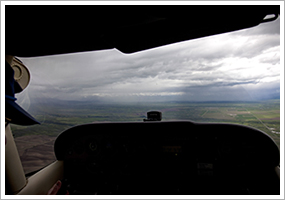training tips  The return leg The return leg The further into the future a pilot needs to forecast weather, the less likely weather is to cooperate. You’ll encounter that fact of aviation life when cross-country training begins. It’s on the return leg of a cross-country, or the later legs of a multi-destination flight, where weather surprises tend to appear. That’s why you should build extra safety margins into planning for flying long distances, or for trips that may require extended time on the ground before returning. You’ll have a good idea of route weather trends if you start checking weather well ahead of your planned departure time. Begin by requesting an outlook briefing whenever your departure time is still more than six hours away. Weather details may still be sketchy, but the big picture is probably emerging. “Such a briefing might help you evaluate your chances of making the flight before planning it out,” explains the article, “The weather briefing,” on the Flight Training website. See the article’s checklist of items to review during a weather briefing. As departure time nears, follow up with a standard briefing. On the ground at your first stop and thereafter, don’t let haste or distractions prevent you from getting more updates. Now it’s time to get abbreviated briefings. How that works is explained in the flight planning article, “Top 10 things a pilot should know about flight service,” on the AOPA website. “The purpose of an abbreviated briefing is to provide you with specific items you have requested to update a standard briefing or mass disseminated information. If you ask for more than two items, specialists are required by the FAA to ask if you want a standard briefing. If you ask for an updated briefing, just let the briefer know what time you had your last standard briefing.”
The passage of time isn’t the only factor that can build uncertainty into weather planning. Consider distance, too. “For longer cross-countries, a rule of thumb is that weather typically changes every 450 miles. But it can also change much more quickly,” cautions the Air Safety Institute’s Safety Advisor WeatherWise: Practical Tips and Tactical Tricks . Staying briefed is the key to good decision making when you’re aloft many miles, or hours, from home! training products ASA 2011 Knowledge Exam products ASA announced recently it has released its line of 2011 knowledge exam products. These include the company’s Test Prep Series, Prepware, and Virtual Prepware. Each features FAA test questions and answers, and other references. Note: Products listed have not been evaluated by ePilot editors unless otherwise noted. AOPA assumes no responsibility for products or services listed or for claims or actions by manufacturers or vendors. final exam Question: I just noticed the address on my pilot certificate is my old address. I know I updated my address with the FAA when I moved. Does it matter that my certificate still has the old address? Answer: Congratulations on meeting the requirement of FAR 61.60, which requires all airmen to notify the FAA within 30 days of a change in their permanent mailing address. This regulation is sometimes overlooked by pilots who don’t realize they can’t exercise the privileges of their certificate until they have informed the FAA in writing of their address change. The fact your certificate still has your old address does not matter as long as the Airmen Certification Branch has your current information. A new certificate will only be issued if you request one. You can do that by filling out form 8060-56: Application for Replacement of Lost, Destroyed, or Paper Airman Certificate or by going to Airmen Online Services and making the request through the FAA’s electronic system. One word of warning, however: The issue date will be updated to reflect the new certificate. Got a question for our technical services staff? E-mail [email protected] or call the Pilot Information Center, 800/872-2672. Don’t forget the online archive of “Final Exam” questions and answers, searchable by keyword or topic. |  The return leg
The return leg

